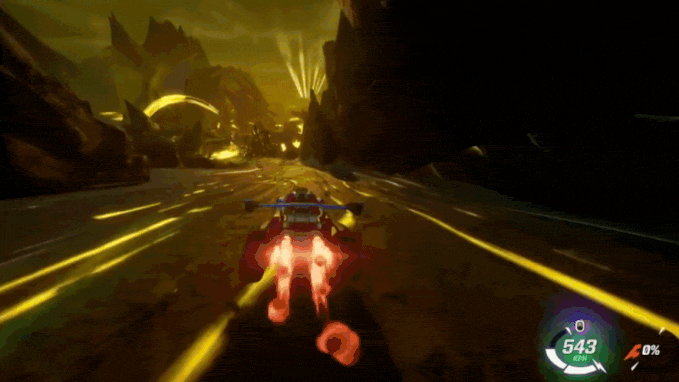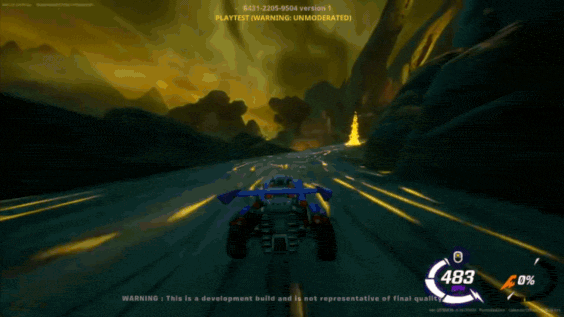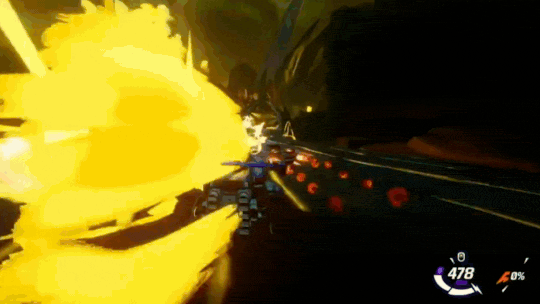The art of designing a memorable race track
How to balance creative vision with technical requirements
Credit: Metallica: Fuel. Fire. Fury, Fortnite, Epic Games
When I was tasked with designing a high-energy, chaotic race track for the Metallica event in Fortnite, I knew coming up with memorable ideas was just one piece of the puzzle. The real challenge was turning those ideas into something that worked, both technically and visually.
In this article, I’ll share how we balanced creativity with execution – guiding players, controlling pace, and creating moments that felt unforgettable. Whether you're designing a level for a game, a virtual environment for an event, or even a user interface for an app, the goal is the same: to bring bold ideas into reality through smart, intentional design.
Design brief
The initial brief was to build something chaotic, collaborative and immersive. While that sounds straightforward, bringing those ideas to life within a race track was a new experience for me.
To begin, I needed to understand not only what makes a track functional, but also memorable. This led me to the research phase. I jumped headfirst into analyzing a variety of tracks, from F1 circuits to go-kart tracks and, of course, video game levels! Part of this was to understand what looked good, but I also wanted to understand what felt good.
One of my key takeaways during this stage was the importance of escalation – the track needed to gradually increase in intensity and complexity to keep players engaged and motivated. Achieving that ultimately came down to the layout of the track.
Track layout design
Although there were multiple avenues to explore during the initial design phase, the three elements that stood out the most to me during the research phase were:
Sharp/banked turns
Track splits
Rhythm and pacing
All of which had previously been used to build tension and create a strong sense of progression over time. For example, both Mario Kart and Trackmania use sharp, banked and even looped turns to keep the track exciting and engaging for players.
Sharp and banked turns
This feature demands more focus from the player. No matter how fast or slow they’re driving, they’ll have to consider braking, drifting or carefully positioning their vehicle to achieve a smooth turn. This helps naturally immerse players, making them feel more involved in the moment-to-moment gameplay.
Straight tracks help build momentum, but without turns, races can feel boring and lack challenge. Turns break up the speed and add variety. By mixing their shape, angle and placement, we were able to create a rhythm that kept players thinking and reacting. This balance makes races more fun and gives players room to improve with practice. The GIF below demonstrates how our turns add excitement and maintain player engagement.
Credit: Metallica: Fuel. Fire. Fury, Fortnite, Epic Games
These learnings on sharp and banked turns were a helpful starting point in building the track, but actually implementing them in engine was a different story!
Attempting to create smooth, playable turns was where the real challenge started to appear. With a banked turn, you can loop it round – really take it as far as you want. However, doing this comes with its drawbacks. In my experience, any turn over 90 degrees led to collision issues, where vehicles didn’t behave as intended – bumping and even causing vehicles to flip. This was purely down to the fact that the spline mesh (a flexible mesh that follows a curved path you define using control points) would often twist or stretch unnaturally, which led to gaps and overlaps in the track.
As a workaround, I found it was beneficial to break sharp turns into smaller segments with evenly spaced control points and smooth tangents. This ultimately ensured I had greater consistency and control over the track layout.
Key takeaway: Turns demand more focus from players by adding challenge and variety, but they also require careful design and implementation to avoid technical issues like collision and mesh distortion.
Track splits
Track splits can be designed to create meaningful choices that impact the flow of each race. Instead of locking players into a single path, splits give them the opportunity to decide – left or right? This decision encourages players to think about the consequences mid-race, adding tension and excitement.
From a gameplay perspective, track splits aid in reducing crowding, encouraging high-speed decision making and introducing meaningful choices that impact the flow of every race. Each route offers something different – like a sharper turn, a shortcut, or a safer path – giving players more ways to react in the moment. These choices allow players to lean into their own playstyle, making each lap feel personal. They also encourage replayability, as players return to try alternate routes and improve their times. See below how one path feels more intense and demanding, while the other offers a steadier pace.
Like with sharp/banked turns, I often noticed gaps and overlaps in the mesh wherever I placed a split, especially where paths would diverge or merge. Not only did this have an impact on the visuals, but the gameplay too – vehicles would bump and bounce along the way.
The solution came down to careful placement of the control points on each spline. Ensuring each control point was evenly spaced and tangents were properly aligned was crucial to preventing those gaps and ensuring a smooth transition between paths.
Key takeaway: Track splits encourage quick decision making, giving players more control and variety. However, they require thorough testing to prevent mesh gaps and gameplay disruptions.
Rhythm and pacing
One of the core goals for this project was to include beat-synching elements. We achieved this by mirroring the emotional highs and lows of the music through player movement. Every ramp, drop, and curve was intended to flow with the music, making the player feel like they were a part of it.
For instance, as the music reached its climactic point towards the end, we decided to design a ramp that launched players into the air at the same moment. Imagine that feeling of flying through the air as the music hits its peak! Adding these events creates a sense of payoff and achievement – really transforming a musical beat into a significant gameplay moment.
Credit: Metallica: Fuel. Fire. Fury, Fortnite, Epic Games
With that said, synching these kinds of moments to player actions was not easy. One design choice that was made early on was to add ‘steps’ to the track layout that the player would hit in time with the music beat. But this led to each playtest feeling inconsistent and unpredictable, which is the opposite of what we wanted.
This is where balancing creative vision with technical requirements really came into play. As a functional alternative, we moved towards widening the scope – using broader rhythmic cues and environmental beat-synched elements, rather than restricting the player to specific timings. This led to elements such as: lava geysers erupting on the beat, lights on the track pulsing rhythmically, and even adjustments to the layout that encouraged bursts of speed.
Key takeaway: Aligning player movement to music enhances immersion, but relying on wider rhythmic elements over strict timing ensures consistency and flow.
What made the final track memorable?
When the visual, musical, and gameplay elements finally came together, it became clear we had created something special – an experience that felt immersive, emotional and unforgettable.
Visual identity
There was a cohesive visual identity throughout the track: a dark, grungy aesthetic with fire, lava and glowing lights that synced to the beat of the music. We needed it to feel powerful, but technically, it had to run smoothly. So we were careful with our placements. Lava geysers and jets were used selectively, and instead of overloading the track with constant effects, we used them strategically to highlight key areas to guide the players’ attention and sync to the beat. This approach ensured players felt fully immersed in the experience, without compromising performance.
Credit: Metallica: Fuel. Fire. Fury, Fortnite, Epic Games
Engaging player moments
Several chaotic elements made it into the final iteration. Jump sequences, swerving through lava, chasing down the band, and even syncing certain moments to the beat. However, too much engagement would have been overwhelming and distracting for the player. So we carefully spaced out key moments to ensure each had a real impact. We wanted the experience to be chaotic, without causing confusion. So with careful balance, we were able to create a track that felt energetic and captivating, without overwhelming players.
Learnings
One of the biggest takeaways from this project was understanding how to align a creative vision with technical demands. Ambitious ideas like beat-synch elements, high-energy racing moments, and visually striking aesthetics all succeeded because they were supported by intentional design choices around structure, pacing, and execution.
The process has shown me that an impactful experience doesn’t necessarily come from doing more, but from making purposeful decisions that support both the creative goals and technical constraints.












